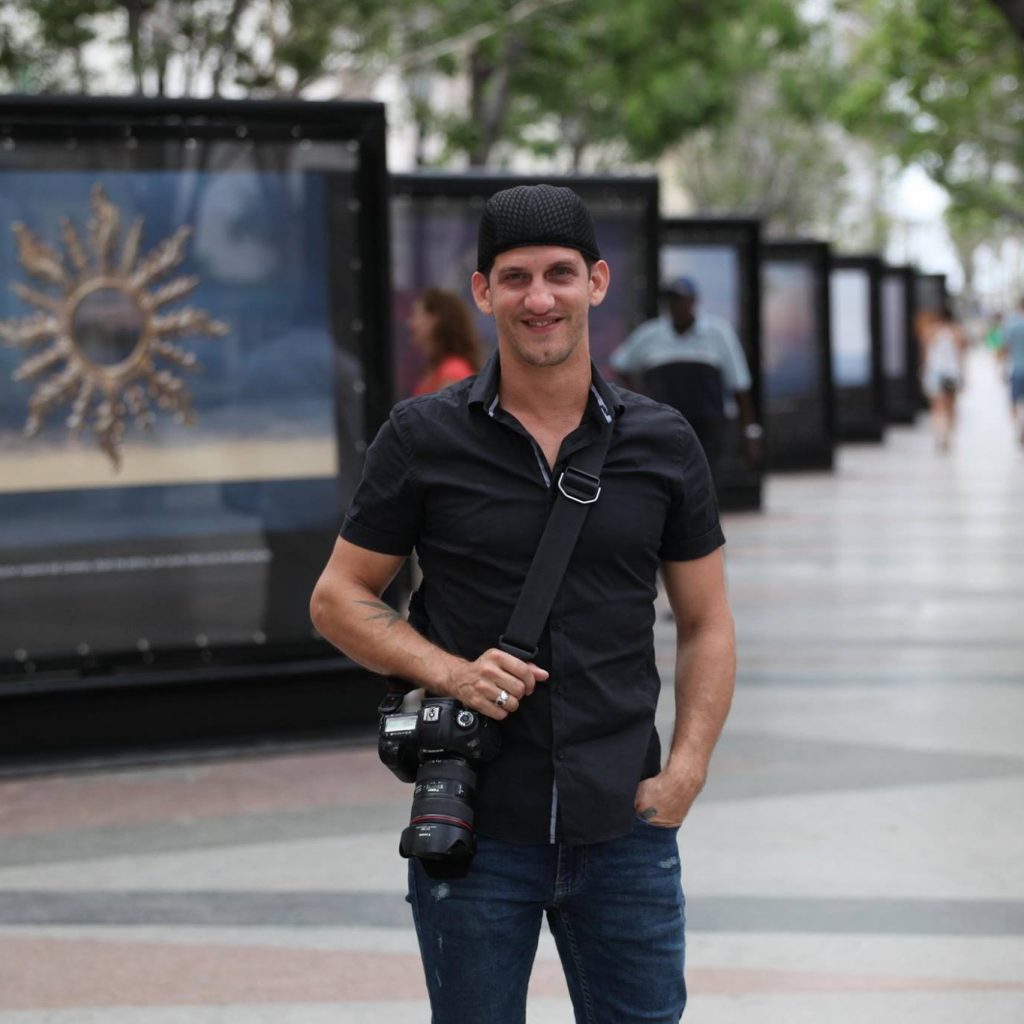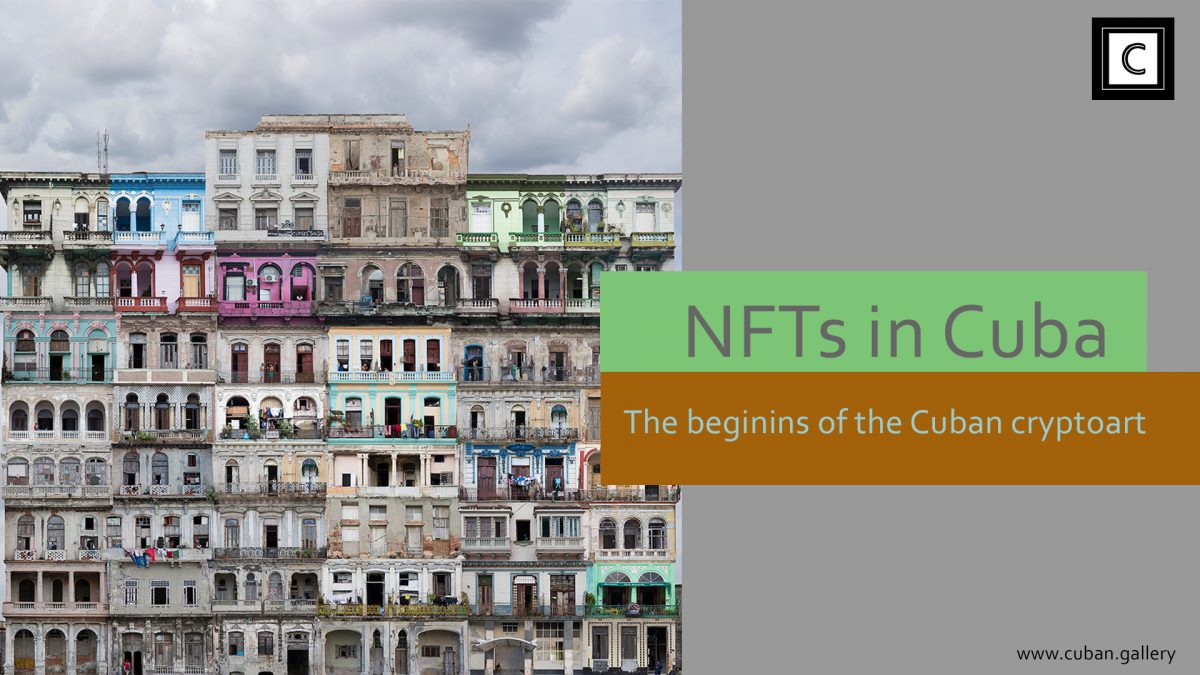The photographer Gabriel Guerra Bianchini is one of the first Cuban artists to experiment with NFTs (Non Fungible Tokens) in the cryptoworld.
Despite he lives in Havana now, after spending several years in Europe, he managed to get the help from people outside the country to publish his first piece in OpenSea.io, a platform for marketing this new form of digital art. He couldn’t do it alone because of the limitations of the embargo of the United States, but a complete stranger paid for his fees to publish his piece Hotel Havana.
“When I decided to launch my first NFT I was clear about which piece it would be. It was going to be “Hotel Habana”. It is a work that took me a year to do, it was very hard. I published the piece as NFT being faithful to how I had already marketed it physically, to the point that the buyer is not only buying the token, the digital file, (if you know the NFT you will know how it works), but I I am also giving him the printed piece so that it makes sense for me, I don’t know if so much for the buyer but for me (it is important) that he can hang his work as I have done with other collectors”, says Bianchini to Cuban Gallery.
How did you make this art piece?
It is a work that consists of something very simple. In my head I saw a surreal building, created as a kind of collage. So what I did for several months was to photograph terraces and balconies of Havana with that rushed and surreal architecture that exists here, and not assemble it as a collage, a photo next to the other in Photoshop, but simply got into something else It is difficult to start welding it from the miniature, from the zoom, the tube that goes through here that gives continuity on this side and thus welds all those photos to create a surreal building, a building that has an impressive resolution; Since each balcony is a photo, you can imagine, I think there are 52 RAW files to create this piece. You print this piece in a giant format because the resolution allows it and it is impressive to discover every detail of each balcony of this architectural madness that exists in Cuba. It is a picturesque way of saying: this is really our architecture, this is what the tourist will receive when they come, not only the beautiful part, this is also our reality.
That work, again, has a very strong sentimental value, so it took me emotionally to finish it. It had an impressive acceptance on the internet, in the networks it walked very fast, two editions were also sold and then taking it to NFT for me gives it added value. The people who buy it will not only receive the file in high resolution of 200x200cm, which is an immense file that they can then take to whatever they want and they create with that work of mine something else that they want to believe, and not only That, they will receive the work to hang it at home. I think what makes it special is this very thing: the Cuban flavor, the fact that Cuban art is coming to this world, in which there are probably many collectors, there may even be many collectors who adore Cuban art and are looking for it today. in the NFTs and finding little, because there is still little. So that’s the value for me to be getting to the NFT market so quickly.

How did you manage to publish and sell your first NFT?
Presenting the first NFT was a titanic task from Cuba, a job that I would not know how to explain, because well, you understand how the market works but now you have to add the limitations of a Cuban artist living in Cuba: the internet, the prices of the internet and the main thing, the Embargo. The Embargo that is real at the moment when you need to access a page where the NFTs are marketed and you cannot because you need a VPN. You download the VPN and some of the pages don’t even open with VPN. Even so I managed to find what it was, with the VPN, and then comes the second most complicated stage. To publish an NFT you first have to pay a tax, sometimes not so small. This tax is paid in Ethereum, in cryptocurrency, I had never had cryptocurrency in my life nor did I know what it was, except for bitcoin and what I had heard.
So I studied that topic too, I looked for a way to buy it and I couldn’t find it. Incredibly, how is life, people and human energy, in one of these conversations about NFT I commented on my experience of what I had managed to do so far, so that they would tell me if I was doing well and the problems that I had encountered. stumbled upon, that he could not buy Ethereum to pay for GAS, which is the tax, and there came out a charitable person, incredible, a 23-year-old boy. He simply called me on Instagram and told me: “Turn on your computer from New York, I’m going to pay you for your GAS, your Ethereum.”
The piece went up for auction for a week. It’s funny how he told me something very nice, because I insisted on finding a way to return the money when it was charged, and he told me absolutely not, he told me something very simple: “Continue the chain of favors. Do this favor for someone else. ” That I have to say so softly so that you understand how exciting it is that there are people like this in the world and what installed me inside, and it was that at the time I published the NFT, that I communicated it on my Facebook, at the moment I said that as soon as I collect that work I am going to take part of those Ethereum to pay the GAS to other Cuban artists so that they can also perform and not have to go through what I went through, and to facilitate the path as they facilitated it to me and continue that chain of favors.
How do you think the crypto art could help Cuban artists?
At the moment I understood that this is very important for Cubans. We are talking about commercializing the works online, in a totally democratized way, without dependence on any gallery or curator, in theory. Logically you have to have good taste, good art, as in everything, but I realized that it is a place with tremendous power. And logically I got to study it as much as I could, first to be able to publish my first work as NFT and then to share that information, because all those questions that I asked myself are being asked by twenty thousand boys in this country right now and why No, if you dabble in it, as they say in Cuba, pass all the honeys, the extract of all that information, have it and pass it on to others so that they can start making use of that application and that way of marketing the work as I am doing. me right now.
THE NFT for Cuba is going to be what it is being for the whole world. It is going to be something very important for the artists. Once again, we live in a country that is an island, also blocked, with ten thousand difficulties, we are in a pandemic, let us not forget and, all these limitations have limited many artists who were already selling their works but who cannot travel , there are no galleries, there are no exhibitions; and others who have not even had that opportunity to have galleries or exhibitions. Well, this democratizes all that: you simply create an account, upload the work you consider and put it up for sale. As simple as that.
Starting from that base, it is a spectacular channel for Cuban artists who can monetize their creations, but especially for Cuban digital artists, the digital world is vast, even music. So it is a fabulous tool. Of course, in everything there is good art, bad art. Then I have received conversations about some curators who do not agree so much. Obviously, it is something new that is coming and settling. When it is posed, there will come the regulations, the ways in which all that will walk. But the reality is that it is fabulous.
How selling NFT could change your life as a creator?
NFTs have great advantages. I’m going to mention them very quickly. The main one is that when you are buying a token, a digital art, what are you actually buying? You are buying the certificate of authenticity and that certificate of authenticity created through the tokens, through the NFT, is the most incredible that has existed in the history of art: it is a decentralized certificate of authenticity, which is replicated in thousands of users , that it is unbreakable, that there is no way to falsify it, there is no way to destroy it and there is no way to erase its trace. In other words, every time you upload a work, the line of the artist who uploaded it, the person who bought it, where it was bought, will remain forever and ever.
The second most interesting thing, which is something surreal, impossible to think about the real world of art as it has been moving until now, is that when you market your work, you have the option of asking to include it in the marketing contract, Through the NFT, let there be 10% or 5%, whatever you decide, that it always comes back to you, in each sale that is made of that work.
To put it in a more practical way: I sell my work today for such a price, a collector bought it, that collector decides to put it on sale tomorrow for whatever reasons and receives a much higher offer. Well, I’m going to get back 10% of that offer that that collector received. It is surreal when you think about it, in which gallery you could have done that; it can not. Those are the great advantages it has, imagination is the limit. What can be sold in a digital world? Everything. Everything can be digitized.



